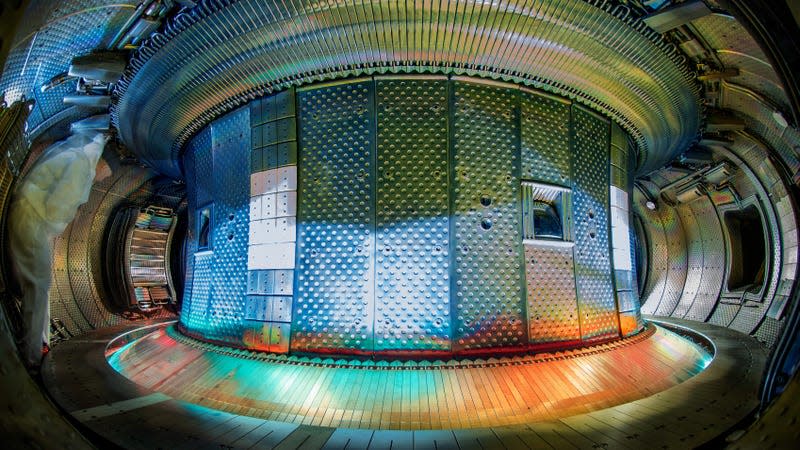New Fusion Record Achieved in Tungsten-Encased Reactor

A tokamak in France set a new record in fusion plasma by encasing its reaction in tungsten, a heat-resistant metal that allows physicists to sustain hot plasmas for longer, and at higher energies and densities than carbon tokamaks.
A tokamak is a torus- (doughnut-) shaped fusion device that confines plasma using magnetic fields, allowing scientists to fiddle with the superheated material and induce fusion reactions. The recent achievement was made in WEST (tungsten (W) Environment in Steady-state Tokamak), a tokamak operated by the French Alternative Energies and Atomic Energy Commission (CEA).
WEST was injected with 1.15 gigajoules of power and sustained a plasma of about 50 million degrees Celsius for six minutes. It achieved this record after scientists encased the tokamak’s interior in tungsten, a metal with an extraordinarily high melting point. Researchers from Princeton Plasma Physics Laboratory used an X-ray detector inside the tokamak to measure aspects of the plasma and the conditions that made it possible.
“These are beautiful results,” said Xavier Litaudon, a scientist with CEA and chair of the Coordination on International Challenges on Long duration OPeration (CICLOP), in a PPPL release. “We have reached a stationary regime despite being in a challenging environment due to this tungsten wall.”
Nuclear fusion occurs when atoms fuse, reducing their total number and releasing a huge amount of energy in the process. It is not to be confused with nuclear fission, the inverse process by which atoms are split to produce energy. Nuclear fission also creates nuclear waste, while nuclear fusion is seen as a potential grail of energy research: a clean process that could be optimized to produce more energy than it took to power the reaction in the first place. Hence the hype around “limitless energy” and similarly optimistic musings.
Earlier this year, the Korea Institute of Fusion Energy installed a tungsten diverter in its KSTAR tokamak, replacing the device’s carbon diverter. Tungsten has a higher melting point than carbon, and according to Korea’s National Research Council of Science and Technology, the new diverter improves the reactor’s heat flux limit two-fold. KSTAR’s new diverter enabled the institute’s team to sustain high-ion temperatures exceeding 100 million degrees Celsius for longer.
“The tungsten-wall environment is far more challenging than using carbon,” said Luis Delgado-Aparicio, lead scientist for PPPL’s physics research and X-ray detector project, and the laboratory’s head of advanced projects, in the same release. “This is, simply, the difference between trying to grab your kitten at home versus trying to pet the wildest lion.”
These are exciting times for fusion (I know, I know, everyone says that). But it’s true! As we reported last year:
Research into nuclear fusion has made slow but significant strides; in 2022, scientists at Lawrence Livermore National Laboratory managed net energy gain in a fusion reaction for the first time. We’re still very (read: very) far from the vaunted goal of a reliable, zero-carbon energy source, and the achievement came with caveats, but it nonetheless showed that the field is plodding forward.
We must stress—as we do any time we’re discussing the possibilities of fusion technology—that the road of progress will be meandering, and slow, and in some cases a boondoggle. Every mountain has its molehills; you won’t be able to know their significance in the context of progress unless you keep climbing.

